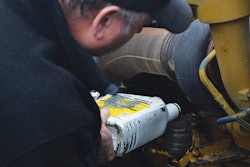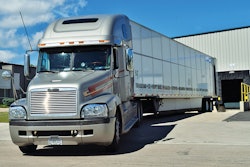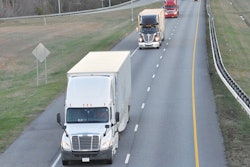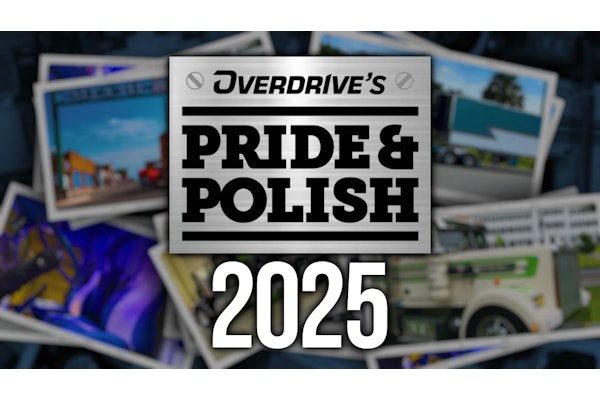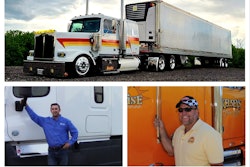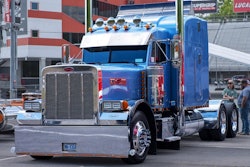PARTNERS IN BUSINESS TABLE OF CONTENTS »
Protect your career by following regulations, practicing safe driving and using data to your advantage
After the truck payment, truck insurance is one of an independent owner-operator’s biggest fixed costs, one that must be paid on time whether a truck is running hard or parked. Without adequate insurance, an accident or cargo claim could mean financial ruin.
THE COST OF PROTECTION
Insurance expenses can add up quickly, which is why many owner-operators budget their premiums a year ahead. Your age, your driving record, the age and condition of your equipment, the commodities you haul, the lanes you run and state requirements all affect insurance costs, but an owner-operator with a new truck and trailer and his own authority is likely to pay:
- • $6,000 or more a year for $1 million in primary liability insurance. This covers damage or injury done to others in an accident.
- • $5,000 a year for physical damage insurance. This covers damage done to your truck and trailer in an accident.
- • $1,000 a year for cargo insurance. This covers damage to or theft of the load you’re hauling.
- • $630 or more a year for $1 million in non-trucking-use liability insurance. Often called “bobtail insurance,” though not necessarily the same, this covers damage or injury to others in case of an accident while you’re not under dispatch.
All that insurance totals almost $13,000 per year, assuming a safe driving record. Cited speed demons can pay much more. For liability insurance, newly established owner-operator businesses in some cases pay that much for liability alone.
Leased owner-operators generally carry just as much truck insurance but pay for less of it themselves. The leased operator should make sure the lease agreement specifies what he is not responsible for, typically primary liability and cargo insurance, and what he is responsible for, typically physical damage and non-trucking liability insurance. Some fleets charge the owner-operator for primary liability and cargo insurance, usually by taking a percentage of all settlements, but other fleets absorb it as part of the cost of doing business.

Owner-operators shopping for bobtail (operating without the trailer) or nontrucking (personal use) liability insurance can look to trucking-specific insurance agencies or truck dealers – or buy direct from the insurance company itself. Shop around before you buy, looking for the most coverage at the most reasonable cost.
Some leased owner-operators buy all their insurance independently of the plans offered by their fleets. This costs more in most cases, but its advantages include more control of your coverage, a closer business relationship with your agent, and a speedier reply when you have an emergency. Better yet, independently purchased insurance is portable, so if you and your fleet part ways, you’re still covered en route to the next orientation. Before you can be assigned a load, you’ll have to show your carrier proof you have all the coverage it requires.
LIABILITY INSURANCE
If you are operating under your own authority, you are required by federal law to have a minimum of $750,000 liability coverage. This is to protect you in a major accident in which you are at fault. You may want to consider higher coverage since a catastrophic truck accident can cost many millions of dollars. Many shippers require carriers they use to carry $1 million in liability to ensure the truck and driver.
Because primary liability insurance is the law, it’s standard in lease agreements. Remember, though, that just because your carrier is insured against damage you cause, it won’t necessarily be on your side in case of an accident. For that reason, some leased owner-operators opt to buy liability insurance independently of their carriers.
For most, however, having liability taken care of is one of the biggest advantages to leasing. Owner-operators who switch to their own authority often are surprised by how costly, complex and time-consuming liability coverage can be, particularly when starting up a first-time business. While a damage policy commits the insurer to paying only the current value of the truck, a typical primary liability policy commits the insurer to paying as much as $1 million if something goes wrong. Moreover, the insurance industry considers owner-operators to be higher risks than fleets, and that earns the insurer only about $6,000 a year in premiums.
Small wonder that the insurer, before signing that contract, wants every assurance that nothing will go wrong. The insurer is likely to quiz an independent about the type of freight to be hauled, the region or operating radius, his background as a driver and as a business person, and regular safety and security practices.
Owner-operators can help themselves by demonstrating they have a solid business plan for the short and long term, including a daily maintenance schedule and routine safety procedures. Bundling different coverages with one insurance company also can help, since most insurance providers offer combined deductibles, meaning in the case of an accident, the driver will have to pay only the typical $1,000 deductible once to cover a damage and liability claim.
With more fleets adopting in-cab video cameras, both road-facing and driver-facing, it’s possible in-cab video systems one day will become a precondition to getting insured – or more likely a factor that can lead to premium discounts, something happening in some quarters today. Some insurance providers, while not offering such premiums, will offer owner-operators a discount on a dashcam purchase or, in rare cases, pick up the cost themselves.
DAMAGE INSURANCE
The law does not require physical damage insurance, but lenders do. A damage policy will pay no more than the value of the equipment at the time of the accident. In other words, you won’t get a new truck out of a damage claim, even if your present truck is totaled. The insurer’s preference always is to go the cheapest route, which usually is repairing the truck you have. At best, you’ll get enough to buy another truck of the same age and mileage.
A typical damage premium is anywhere from 3 percent to 5 percent of the truck value, or $3,000 to $5,000 for a truck worth $100,000. A bad driving record, however, can bump the cost to 8 percent a year or more – if you still can get damage insurance at all. If you buy damage insurance from a truck dealer financing your truck, your truck payments are higher, and your interest costs go up. It may be less expensive to get insurance through an independent agent.
Make sure that damage policies don’t count the cost of towing as part of a settlement. If they do, thousands of dollars of any settlement will go not to repairs but to the tow company. You’re better off getting extra coverage for towing.
GAP INSURANCE. Since an owner-operator can owe more on a truck than it’s actually worth due to depreciation, a damage settlement may not be enough to make the rest of the payments on the totaled rig. If you’re driving a new truck or a used truck not more than five or six years old, gap insurance might be helpful. It covers the difference between the actual book value of the truck and what you owe on the truck. If the market value of your truck is $60,000, but you have a loan balance of $70,000, you would be short $10,000 to pay off the loan in the event your truck was totaled. Gap coverage would make up the $10,000 shortfall.
DAMAGE DEDUCTIBLES. Besides the premium, the other important number in a damage formula is the deductible. A deductible of $1,000 means the policyholder agrees to pay the first $1,000 of expenses before the insurance kicks in. The higher the deductible, the lower the premium.
Ask your agent for a range of prices at various deductibles, low to high. Deductibles of $1,000 are typical. A top-of-the-line rig may have deductible options as high as $10,000. Low to moderate deductibles, however, are the best choices for an owner-operator. A high deductible is no bargain if an accident puts you out of business. If the deductible in your fleet policy is too high for comfort, you can buy insurance that will pay that deductible for you. Such “deductible buyback” insurance generally is cheap.
COVERAGE OF OTHER EQUIPMENT. Any truck equipment not covered in a basic damage policy — such as auxiliary power units, tarps, binders and chains — can be added by the owner-operator at minimal cost. A basic damage policy likely won’t cover the cost of replacing a tank full of diesel that spills in an accident, or any other fluids that need replacing afterward. Boilerplate damage policies typically cover only permanent manufacturer-installed fixtures on the truck, not any extras added later such as satellite radio or chrome. All can be covered for a small fee, but the insurance company has to know the items are there.
CARGO INSURANCE
The federal government ended its requirement for $5,000 in cargo coverage for interstate carriers in 2011, but shippers continue to require it of carriers hauling their freight. Fleets typically buy $100,000 on the owner-operator’s behalf, which is the amount mandated by many shippers. Specialty haulers can carry far more.
The fine print in some lease agreements charges the owner-operator for any cargo losses if he’s at fault in an accident, cargo insurance or no cargo insurance. Some loads have a higher value than an owner-operator’s cargo insurance can cover. Yet owner-operators often don’t know who’s liable for the difference if an expensive load is lost. See what your policy covers before an emergency occurs.
NON-TRUCKING-USE LIABILITY INSURANCE
The name of this insurance, which covers you when you’re not under dispatch, is a more precise term for what used to be called “bobtail insurance.” The meaning of “under dispatch” sometimes has to be determined in courtrooms. Courts have held that even a bobtail trip home can be considered under dispatch, since the route is determined by where the fleet most recently sent the driver.
Sometimes the fleet’s insurance company refuses to pay a claim, arguing the owner-operator was not under dispatch at the time, and the owner-operator’s insurance company likewise refuses to pay, saying he indeed was under dispatch. In these cases, the owner-operator is caught in the middle and probably needs a good lawyer himself.
Non-trucking-use liability coverage is required by the majority of carrier leases. The cost is typically $50 or more per month.
Download the entire Partners in Business Manual
Chapter 1: Becoming your own boss
Chapter 2: Bookkeeping and business analysis
Chapter 3: Understanding your revenue and costs
Chapter 5: Controlling fuel costs
Chapter 6: Controlling tire costs
Chapter 8: Income tax and other taxes
Chapter 9: Choosing a business structure
Chapter 10: Truck buying, leasing, financing
Chapter 11: Choosing a trailer
Chapter 12: Maintaining your equipment
Chapter 13: Choosing a carrier
Chapter 14: Computers, mobile devices and the internet
Chapter 15: Staying compliant and safe
Chapter 16: Trucking insurance



